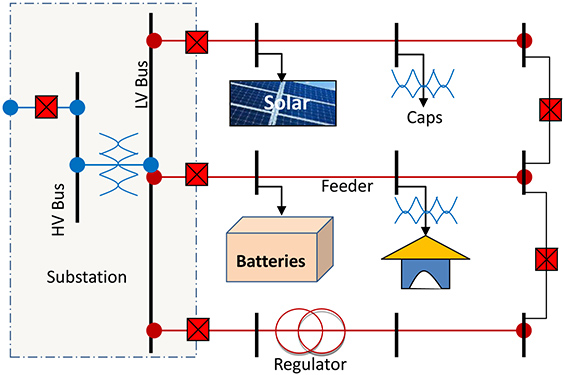Introduction
Ryerson University founded the Centre for Urban Energy (CUE) in September 2010 along with founding sponsors, Hydro One, Ontario Power Authority (OPA), and Toronto Hydro. Ryerson University has invested about $1.5 million towards the Centre’s infrastructure and devoted significant manpower towards its development and operations. Founding sponsors Hydro One, Ontario Power Authority and Toronto Hydro have invested around $7 million towards research projects, research fellowships and student awards. These sponsors further contribute to the success of the centre through countless hours of manpower by participating in research projects and other activities at the Centre.
Since its inception, the Centre for Urban Energy has initiated 18 large projects on topics such as smart grids, energy storage, transmission and distribution system analysis renewable energy, . A few projects have been completed such as the design of controller for Temporal Power’s flywheel, energy storage system. Currently, is pursuing a flagship project on energy storage in batteries worth $8 million in collaboration with Natural Resources Canada, Hydro One, Toronto Hydro, OPA, Ontario Centres of Excellence, Electrovaya, Manitoba HVDC, Manitoba Hydro, and Tennessee Valley Authority.
The facility also operates an incubator for encouraging innovators from Ryerson and all other Ontarians to bring new productize-able ideas for research and commercialization. CUE has several projects where it collaborates and partners with other also Ontario universities such as Western University, University of Waterloo, University of Ontario Institute of Technology, York University and University of Toronto.
The vision of this centre is to be a world class research and innovation centre dedicated to solving urban energy challenges. In addition to Research and Development, CUE shall pioneer in large utility scale demonstration projects that shall facilitate innovation and commercialization of groundbreaking energy solutions of the future.
Smart Grid Laboratory
Now that the Centre for Urban Energy has been operating for three years, it is looking to expand its operations by building a smart grid laboratory with several characteristics: research, innovation, testing and education.The lab has been made possible by the generous funding from Schneider Electric and the Ontario Ministry of Energy.
Purpose of the Laboratory
The laboratory shall be a multifunctional laboratory mimicking – in a reduced scale – an automated distribution system at 3-phase 600 V. The essential components of this laboratory shall include:
- Solar panels with inverters (controlled)
- Energy storage (batteries) with controlled bi-directional converters
- Controlled AC Loads with AC-DC-AC back-to-back converters
- Controlled DC Loads with rectifiers
- Circuit breakers with IEC 61850 interface
- Transformers
- Relay equipment including ECTs and EVTs
- Hardware for IEC 61850 ring
- A Distribution Management System (DMS) including hardware and software

At Ryerson University, we will study, develop and implement the following smart grid projects:
- Supervisory Control
The network, as shown in Figure 1, can be isolated by opening circuit breaker CB1. On achieving generation and load balance, the system can be operated as a microgrid. The purpose of such research work is to implement, test and demonstrate converters and inverters that can be used for frequency control of an islanded system. Furthermore, this shall enable demonstration of supervisory control and protection of the microgrid.
- Harmonics Study
Of concern to utilities, is the impact of harmonics on assets such as transformers and capacitors. This laboratory shall try to study, measure, quantify, and understand the impact of harmonics from sources with power electronics on transformers. As can be seen, the laboratory architecture lends to this type of investigation. Studies shall be undertaken to quantify harmonic effects, at various levels of generation by these sources, on assets such as transformers. Parameters such as total harmonic distortion shall be studied. Their cumulative effect of these generation sources on assets shall be studied as well.
- Optimize 24-hours Energy Consumption
For large customers such as high rise condominiums, hospitals, universities, hotels and other dense energy users, energy bills and reliability of supply is a concern. They all own, operate and maintain backup diesel generators. As can be seen, the DS architecture is comparable to such large users. An aim of this laboratory is to develop and implement a 24-hour scheduling system such that energy bills are minimized (by energy arbitrage) and reliability is maximized for overcoming any supply failure through energy storage.
- Microgrid Operation
In future, microgrids shall be a commonplace in large customer sites – with comparable AC and DC Networks. This laboratory shall establish a microgrid when circuit breaker CB1 opens. Near term load forecasting, short term load forecasting, load management, operation improvement, energy storage optimization – and DG management are also the essential functions for microgrid operation.
- Protection and Coordination
Protection and control methods for microgrids are a topic for future study. This laboratory shall undertake research in this direction to develop appropriate protection schemes and relaying techniques. Further, the laboratory shall have switchgear that enables fault isolation and restoration.
These futuristic switchgear solutions require appropriate developments in protection and relaying equipment. Research and innovation efforts in this laboratory shall focus in that direction.
- Advanced Metering Infrastructure (AMI)
A portion of the smart grid laboratory will become an advanced metering infrastructure (AMI) test facility. It will allow new metering products and innovations to be plugged in and tested ahead of industrial scale pilots. The laboratory shall be a neutral site engaging in non-revenue type feature testing.
In addition, efforts are being undertaken to explore the possibility of using advanced metering infrastructure to enable local energy commerce, improve system reliability, provide improved distribution system performance. Research, innovation and demonstration efforts in this laboratory shall focus on creating next generation solutions using advanced metering infrastructure in tandem with advanced distribution management systems.
- Pilot Testing
The Centre for Urban Energy is big on pilot testing of new and innovative products. It provides a neutral testing opportunity for products of interest for utilities and energy innovators. Examples are the Electrovaya battery testing, Temporal Power flywheel, IceBear thermal energy storage (sponsored by Toronto Hydro). The proposed laboratory will help in testing smart grid ideas on a utility scale demo right here in Ryerson’s downtown campus. It will provide easy physical access and remote access internet. This collaborative space shall provide a unique opportunity Ontario institutions for the testing and demonstration of smart grid products.
- Conservation and Demand Management
Conservation and demand management technologies and solutions are being championed in Ontario. These solutions enable demand-supply balance by avoiding new generation through either conservation programs or demand response tools. Conservation programs reduce net energy consumption. The other tool is demand management where peak demand is reduced during peak hours thereby reducing clearing prices. Which has has a profound effect. In the province of Ontario, these programs are rolled out via distribution companies. This laboratory will enable development of new conservation and demand management solutions.
Which can also be pilot tested and validated in the same space.
- Other Research and Innovation
Several smart grid projects are underway at Ryerson University’s Centre for Urban Energy, the University of Waterloo Institute of Sustainable Energy, Western University and other institutions in Ontario such as the Clean Energy Institute. These include algorithms and products for analysis, control, and optimization of smart grid elements such as advanced distribution systems and microgrids. These research and innovation products need a venue for pilot testing and demonstration. This laboratory shall provide an industrial test bed for such pilot testing and demonstrations for developers, investors and other international participants who might wish to engage and benefit.
- Education
The Centre for Urban Energy hosts 10 student projects on smart grids from the Department of Electrical and Computer Engineering each year. They are funded through generous grants from Hydro One and Toronto Hydro. These students will directly benefit by being trained in this state-of-the-art facility. Ryerson University has also announced plans for graduate programs in Energy and Innovation. Students in these graduate programs shall have a four-month internship in this smart grid laboratory as a part of their curriculum. Creation of this laboratory shall directly facilitate training of highly qualified personnel specializing in smart grids contributing to provincial economy.
About the Author
 Dr. Bala Venkatesh is both founding Academic Director and head of the Ryerson Centre for Urban Energy (CUE). He currently serves as a Professor of Electrical Engineering at Ryerson and has also taught at the University of New Brunswick, Multimedia University (Malaysia), and Anna University (India). He has published more than 100 articles in journals and conferences and has supervised 34 MASc and PhD theses. In total, his extramural funding is more than 10 million dollars. He is a registered professional engineer in Ontario and, in the last two decades, has worked on over 10 consulting projects in India and Canada.
Dr. Bala Venkatesh is both founding Academic Director and head of the Ryerson Centre for Urban Energy (CUE). He currently serves as a Professor of Electrical Engineering at Ryerson and has also taught at the University of New Brunswick, Multimedia University (Malaysia), and Anna University (India). He has published more than 100 articles in journals and conferences and has supervised 34 MASc and PhD theses. In total, his extramural funding is more than 10 million dollars. He is a registered professional engineer in Ontario and, in the last two decades, has worked on over 10 consulting projects in India and Canada.







